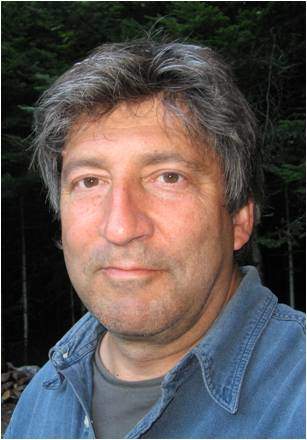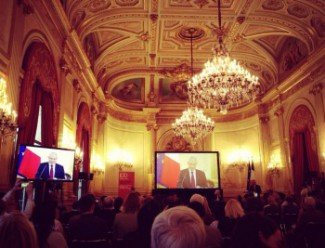National Wildlife Federation Adopts Key Element of Steady-State Thinking
by Eric Zencey
 The National Wildlife Federation held its annual meeting near Capitol Hill in Washington, D.C. on Friday, April 15. The meeting took a bold, firm step toward implementing a key feature of steady-state economic thinking: it passed a resolution calling on the President, Congress, state governors and state legislators to abandon gross domestic product (GDP) as the indicator that economic policy makers seek to maximize, and to develop and adopt instead a broader measurement of economic and ecological well-being.
The National Wildlife Federation held its annual meeting near Capitol Hill in Washington, D.C. on Friday, April 15. The meeting took a bold, firm step toward implementing a key feature of steady-state economic thinking: it passed a resolution calling on the President, Congress, state governors and state legislators to abandon gross domestic product (GDP) as the indicator that economic policy makers seek to maximize, and to develop and adopt instead a broader measurement of economic and ecological well-being.
The resolution passed unanimously, as delegates from 47 states and two overseas territories said “aye,” no one said “nay,” and the resolution was gaveled into force. I was there representing the Vermont Natural Resources Council, which had put the resolution on the agenda. The vote was a quiet moment in a large conference hall, with delegates shuffling papers as they sat at long tables facing the dais, each of us fronted by a miniature version of our state flag. This is what revolutions in political economy sometimes look like: quiet meetings in stuffy conference halls in which concerned citizens say, in unison, “Stop doing that and do this instead.”
In passing the resolution, the Federation lends its considerable support to an international movement that seeks to alter what we count as progress. That change—measuring the actual well-being delivered by the economy instead of the amount of money that changes hands each quarter—is crucial to establishing a sane, sustainable, steady state economy.
Every economics textbook warns that GDP is a poor measure of well-being, and yet by default it continues to be the indicator that economic policy seeks to maximize. GDP doesn’t measure well-being at all, but simply tries to tally the dollar value of final goods and services produced in the U.S. By design, it leaves out volunteer work and domestic production—the daycare you do at home doesn’t count, but if you commercialize the transaction by dropping your kids off at the daycare center, GDP goes up. Cooking, cleaning, maintenance, yard work, caring for aging parents—none of it counts if money doesn’t change hands. Neighborhoods, communities and households all benefit mightily from this kind of non-commercial production, and their replacement by commercial services often fails to bring the same level of satisfaction and well-being.
By design, GDP also leaves out ecosystem services; if you hang your laundry out to dry, the sun and wind do the job, but if you throw it in the dryer you use electricity, increase your carbon footprint, and give GDP a bit of a bump. Ecological economists identify a dozen categories of ecosystem services, including climate stability, recycling of nutrients, creation of soil fertility, maintenance of a library of genetic diversity, pollination, purification and transport of water by the solar-powered hydrological cycle, flood protection services of marshlands and forests, and so on. Ecosystem services count for nothing in GDP. If we don’t value them, they are easily ignored. Yet the loss of ecosystem services leads, eventually and inevitably, to the loss of civilization itself.
GDP also misreads our level of well-being by treating defensive and remedial expenditures as positive economic activity. Remedial: the $12 billion that British Petroleum alone has spent (so far) in its efforts to clean up the catastrophic oil release in the Gulf of Mexico counts as an increase in GDP, though the expenditure comes nowhere close to putting things back to their pre-Deepwater state. Defensive: if someone breaks into a neighbor’s house and you decide to buy a burglar alarm, GDP goes up—but you probably don’t feel as secure as you did before the break-in.
Economic growth brings us problems, and as we spend money to deal with those problems (e.g., trucking in water to replace the services of an aquifer contaminated by mountaintop-removal coal mining, adding treatment plants to purify drinking water fouled by chemical discharges, or turning up the air conditioning because smog and particulate matter make opening a window an undesirable option), GDP goes up. By some estimates, as much as one-quarter to one-third of our GDP consists of such expenditures.
If we’re ever to have a sustainable, steady state economy—an economy that operates on a sustainably sized flow of matter and energy, and which excretes outputs that can successfully be absorbed by the ecosystems of the planet—we need to start measuring what matters, and not mistake the commotion of money for the creation of well-being. Steady-state economics doesn’t mean that our quality of life will stagnate; we can have continual improvement in social and cultural well-being as we spend less on remediation and repair. Ecological economists call this development to distinguish it from footprint-enlarging growth. And this is the key to steady-state thinking—we have to stop growing our ecological footprint (which is already too large to be sustained) and begin budgeting our economy within the limits of what we can sustainably extract and emit. The National Wildlife Federation did not specifically sign on to the steady-state vision; but by calling for an accurate measurement of the costs of economic growth, it has officially joined us on a path that can lead nowhere else.
The resolution passed by the annual meeting reads, in part,
…be it resolved that the National Wildlife Federation urges the President, the Congress, and state Governors and legislatures to take immediate steps to redesign the use of the Gross Domestic Product as an indicator of economic well-being, and to take all necessary action to develop and implement a system of economic accounting that gives a more accurate measure of overall economic and ecological well-being; and be it further resolved that the new or modified system of national accounts should treat as cost or debit items the depletion of finite, non-renewable natural resources and the loss and degradation of ecosystem services, including the service of providing habitat for wildlife.
The Federation is, as the name implies, an umbrella organization that offers central administration and the strength of shared purpose to its affiliate organizations. It’s the largest environmental advocacy group in the nation, with affiliates in 47 states, several territories, and a total membership of 1.5 million members. The organization brings together hunters, anglers and sportsmen, on the one side, with hikers, backpackers, and birders on the other, with a good strong mix of environmentally aware citizens thrown in as well. It’s a broad coalition bound together by a shared understanding of the need to protect wildlife and wildlife habitat—ecosystems and their genetic diversity.
In its seventy-five year history, the NWF has fought and won a lot of battles, from the Pittman-Robertson Wildlife Restoration Act of 1937 (which for the first time provided Federal funding for wildlife programs), through the 1944 invention of the concept of the environmental impact statement and its eventual adoption into law, and on through a leadership role in the major environmental legislation of the 1960’s and 1970’s: the Clean Water Act of 1963, the Endangered Species Preservation Act of 1966, the National Environmental Protection Act of 1969, the dramatically expanded Clean Water Act of 1970. The Federation is an active litigator, using these laws and others to block unwise economic activity and protect the nation’s ecosystems. It’s safe to say that without the Federation, many of the ecosystems of North America would be not just threatened but degraded to the point of collapse.
Begun by a group of outdoorsmen who saw their beloved wilderness areas, and the animals in them, being threatened by the encroachment of economic activities, the Federation has in its seventy-five year history broadened its approach. As a history of the Federation puts it, “While the NWF continues to champion threatened species, its work has evolved to embrace a multi-species, ecosystem approach.” (source: “What We Want is Action,” by Jessica Snyder Sachs in National Wildlife, February/March 2011, p. 27.) It also broadened its reach in another way: “we began seeing the patterns,” says former NWF counsel Patrick Parenteau, “and attacking the root causes of such problems.” (quoted by Sachs, p. 25.) The adoption of the economic indicators resolution is a continuation of this trend, reaching beyond symptoms to address the problem at its source.
The root cause of our environmental problems—our ecological crisis—is infinite planet economic theory, the rules and axioms of a discipline that tells us that it is possible to have infinite economic growth on a finite planet. It sounds crazy, doesn’t it? But neoclassical economists continue to believe this is possible because human ingenuity is a factor of production and, supposedly, it is infinitely powerful. You can get to that conclusion only if you ignore the laws of thermodynamics. Economic production is, at bottom and unalterably, a process that relies on physical inputs. No amount of human ingenuity will ever let us make something from nothing or nothing from something. No amount of ingenuity will let us create energy out of nothing or recycle it to use it again.
In the real world outside of infinite planet theory, our acts and works are constrained by physical law. Those laws tell us that increasing our matter-and-energy throughput has unavoidable consequences in the world. It damages ecosystems, leading to the loss of (sometimes irreplaceable) ecosystem services. We can’t count that loss as a cost unless we first value ecosystem services as a benefit and adopt an indicator other than GDP as the one we seek to maximize. With the passage of this resolution, the National Wildlife Federation commits to lending its considerable energies and expertise to that effort.





Real world non-news fit for non-reporting; FUKUSHIMA IS IN MELTDOWN.
The greatest health danger in the history of the world is NOT being reported in any mass media.
U tube has some credible info.
Gigantic areas & ecosystems, top entire top third of Japan,, being lost forever from FUKUSHIMA catastrophe.
Why not write about it?
Nice to hear about the NWF´s policy. I think it certainly makes a strong contribution to the policy issue side of the matter. Cobb et al wrote a great article in the Atlantic in 1995, and E Magazine had a great article by Baker in 1999 which mentioned Sen. Byron Dorgan´s efforts in the Senate. Redefining Progress and F of the E UK have been doing some fine activism on the issue.
As an activist oriented supporter of the steady state perspective, however, I understand things a bit differently. The infinite planet theory is only one dimension of the GDP growth view, and much is driven by associated perspectives such as the goal of “profit-maximization” and employee disenfranchisement. Ultimately, these are at least in part social economic dimensions, especially the latter.
CASSE´s Enough report does discuss some elements of corporate governance and local ownership issues. The Fair Trade Certification movement which uses the co-operative business model is an effective example of the principle. Jonathan Rosen´s book Equity looks at many conventional examples in the US, while William Greider´s book The Soul of Capitalism does a similar survey, but with some additional elements including touching on Daly´s ideas and David Ellerman´s important work.
Green America is an NGO doing important work in FAir Trade issues, as is Oxfam. American Rights at Work is more labor rights oriented, but such issues are also an important human dimension in looking at Steady STate perspectives.
A step in the right direction,
While it would be good to find other measures, we should also not exaggerate the effects of doing so. We have measured the number of hungry people in the world for many decades and the numbers are still appalling. We measure climate change, but it hasn’t impressed politicians or citizens enough the take radical action. We need to keep separate the efforts to analyze our economy with alternative measures and terms and possibilities to manage our economy in that way. These various measures and indicators don’t change the reality of economic agents, in particular companies. Companies are not trying to grow the GDP, they try to increase their profit or simply survive the competition. Even when they speak about “triple bottom line” and other niceties, increasing the profit will always be the overarching driver. And this will remain the same even if societies trash GDP as a measure. Similarly, consumers don’t buy more stuff to contribute to the GDP, they buy more stuff because it gives status or satisfaction or simply because they have money to spend, “money burning a hole in my pocket” as the saying goes. The effect of these measurements is on the political discourse mainly. So it is good, but it is just a small step.
read more: http://gardenearth.blogspot.com/2010/11/how-we-measure.html
Governments like GDP because it’s a measure they can manipulate in their favor by borrowing and spending. GDP is one main reason why DC cannot kick the borrowing and spending deficit. If they do, we will see their economic outlook is vapor… According to GDP, an underemployed college grad is growing economically because they are purchasing with a new credit card in place of the others they have maxxed-out.